Canon IVSB of December 1953
A Description of a Major Innovation in Canon Rangefinders
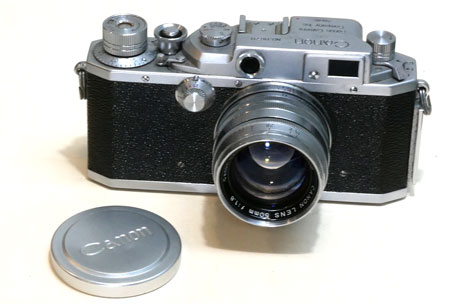
Canon IVSB with solid chrome Canon 50mm f1.8 Canon lens
Canon IVSB rangefinder camera of December 1952
In his comprehensive study of Canon rangefiner camera, Peter Dechert wrote:
"The Canon IVSB was after the IIB the second most important rangefinder camera model in Canon's history." 1
The reasons for this importance include:
- it was the first Canon rangefinder to include flash synchronization for both flash bulb and electronic strobe flash
- it used the fully compatible universal M39 lens mount thread
- it featured the improved shutter with 1/1000 second speed
- it used the new solid camera body construction
- it featured the Canon's three position integrated viewfinder-rangefinder with rangefinder focusing superimposed in the viewfinder. Leica did not combine the rangefinder - viewfinder image until two years later.
Canon's history website 4 also states that the IVSB was the world's first camera synchronized for electronic strobe flash. For this reason, the Canon IVSB began to be adopted also by professional photographers who could also use the camera with all their Leica lenses if they chose.
These characteristics made the Canon IVSB the first Canon camera widely accepted in North America and in Europe.
Canon IVSB Flash Synchronization
Canon built a new rail on the camera side for connection to Canon flash units.
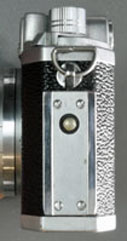
This bracket allowed both an electrical connection to a flash unit, but also a solid physical connection to the camera. Other cameras which included flash synchronization generally used either a pin or a coaxial electrical connection. However, they then required a wire going to the flash unit, and the flash mounted on a bracket connected to the tripod socket. Alternatively sometimes a flash was connected, less securely, attached to the accessory shoe of the camera. The accessory shoe was generally too weak for prolonged flash connection.
This Canon solid bracket continued to be used on all synchronized Canons until the new connection of the Canon VT in 1956.
Canon offered a series of Canon flash accessories for connection to the flash bracket. An example was the Canon Flash Unit X which slid onto the flash bar. The bar could also connect to electronic strobe units such as the early Bell & Howell strobe of the mid-1950s shown below.
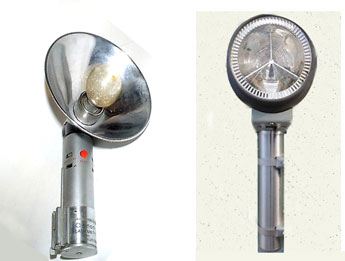
Canon Flash Unit X and Bell & Howell strobe unit of mid 1950s
The Canon flash unit programme was extensive and included a number of accessories for controlling and measuring the artificial flash effect.
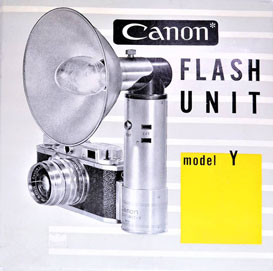
Canon Flash Unit Y
Canon IVSB Base and Canon Film Cartridge
The Canon IVSB also had a new base with a key which opened the camera bottom, and also allowed the photographer to open and close a Canon Film Cartridge.

Canon produced its own film cartridges - the Canon Film Cartridge - into which 160 cm or 5 feet (36 exposures) of 35mm film could be loaded in a darkroom. The cartridge installed inside the camera was keyed open and closed by this bottom key. During photography, film could then travel free without the felt-type light trap of Kodak 135 film cartridges. Some photographers believed that this Kodak light trap could abrade the film surface. Of course, the camera could also take these standard Kodak 135 35mm film cartridges.
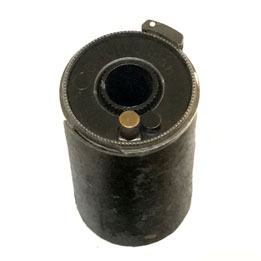
Canon film cartridge of early 1950s
With the launch of the Canon IVSB in December 1952, Canon also offered a full
range of Canon lenses. Some of the existing lens production was still labeled
"Serenar", but all the Canon IVSB cameras sold were with 50mm lenses labeled
"Canon". The range included included the 35mm f3.2, the 85 mm f2.0, the 100mm f4.0,
and the 135mm f3.5, as well as a choice between the 50mm f1.8 or the 50mm f1.5.
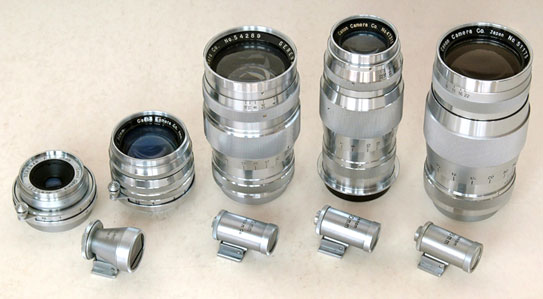
(l to r) Canon 35mm f3.2, 85 mm f2.0, 100mm f4.0, 135mm f3.5.
As well as the "super-speed" 50mm f1.5, Canon launched the 85mm f1.5.

Canon 85mm f1.5 in chrome
Canon also referred to the Canon IVSB as the "Canon IVS2" as can be seen in this USA instruction book for the camera.
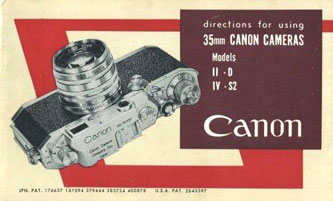
With the success of the Canon IVSB and its accessorites, and full range of lenses, Canon promoted it as a system, as shown in the New York City advertisement.
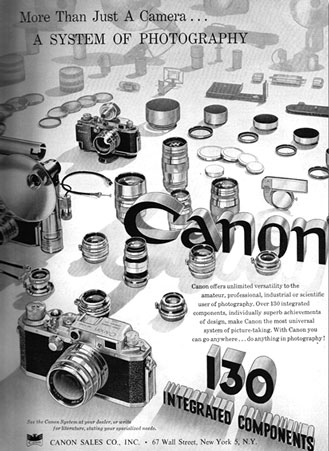
The success of the Canon IVSB led not only to the acceptance of the Canon rangefinder internationally, but also to a series of successful Canon cameras launched 1953 to 1956 based on teh Canon IVSB design. You can read about these cameras by clicking on the links below.
You can click on the links in the table below to consult other pages of the canonrangfinder.org site.
| Navigation: Click Below to Jump to Desired Subject Page | ||
|---|---|---|
| Canon Rangefinder Cameras - 1 | Canon Rangefinder Cameras - 2 | Canon Rangefinder Lenses |
| Canon Hansa | Canon IIAF, IIAX | Development Nikkor 50mm |
| Canon S | Canon IVSB2 | Canon 19mm |
| Canon J | Canon IIS2, IID2, IIF2 | Canon 25mm |
| Canon NS | Canon VT, Canon L2 | Canon 28mm |
| Canon JS | Canon L1, L3 | Canon 35mm |
| Canon S-I | Canon VT Deluxe | Canon 50mm |
| Canon J-II | Canon VL, VL2 | Canon 85mm |
| Canon S-II | Canon VI-L, VI-T | Canon 100mm |
| Canon IIB | Canon P | Canon 135mm |
| Canon III, IIC, IV | Canon 7 | Canon 200mm-1000mm |
| Canon IIIA, IVF, IVS | Canon 7s | Canon Accessories |
| Canon IIA, IID, IID1 | Nicca Rangefinders | Canon Finders |
| Canon IVSB | Leotax Rangefinders | Minolta Rangefinders |
| Canon IIF, IIS | Other Rangefinders | Minolta Lenses |
| Comparison Canon - Nikon Rangefinders | other M39 lenses | |
| Go to canonrangefinder.com home page | ||
Any additions or corrections to these pages would be welcome simply by contacting this site as shown at the foot of this page .
Footnotes:
1 Dechert, Peter. Canon Rangefinder Cameras 1933-1968. Hove Collectors Books. West Sussex, United Kingdom. 1985. ISBN 0-906447-30-5.
Peter Dechert's book is the most important expert source of information regarding Canon Rangefinder Cameras.
2 Kitchingman, Peter. Canon M39 Rangefinder Lenses 1939-1971. A Collector's Guide. Published by Peter Kitchingman. Perth, Australia. 2008. ISBN 978-0-646-48144-9.
Peter Kitchingman's book is the definitive study of the more than three decades of M39 format camera lenses developed for Canon Rangefinder Cameras.
3 Nostalgic Canon Camera Book. 懐かしいキヤノン EI Publishing Co. Ltd. Tokyo, Japan. June 2003.
Peter Kitchingman's book is the definitive study of the more than three decades of M39 format camera lenses developed for Canon Rangefinder Cameras.
4 "Canon Camera Museum" history website. https://global.canon/en/c-museum/history/ published by Canon, Inc. accessed in 2019.
5 Rajner, Hans P. (author), John Wade (editor). Leica Copies. Classic Collections Publications. London, UK. ISBN 13: 9781874485056
Hans P. Rajner's book is an excellently detailed and carefully researched study of camera from around the world which used the Leica M39 lens mount and the same lens to film plane distance.
7 Dechert, Peter. Canon Single Lens Reflex Cameras 1959-1991. Historical Camera Publications. Yakima, Washington. 1992. ISBN 1-879561-04-2.
8 Tomlinson, Shawn M. The Film Photography Book. Lulu Pulbications. 2016. ISBN: 9781365263972
9 Sartorius., Ghester. Identifying Leica Lenses. Classic Camera 19. Tokyo, Japan. 2001. ISBN 4-257-12029-0
10 website http://www.nicovandijk.net/rflensmatrix.htm consulted 2019.
11 O'Reagan, Douglas M. Allied Exploitation of German Science after World War II. Johns Hopkins University Press. Baltimore, Maryland. 2019. ISBN 9781421428888
12 website www.canonrangefinder.servehttp.com consulted 2008.
13 Minolta expert Andrea Aprà has posted information on minoltarangefinders group and other groups and further detailed information by email. (thanks Andrea !)
14 website http://www.collection-appareils.fr/objectifs/ consulted 2019.
15 Small, Marc James. Non-Leitz Leica Thread-Mount Lenses. Wittig Books. Hückelhoven, Germany. 1997. ISBN 3-930359-47-2.
16 the Nikon Corporation website: https://imaging.nikon.com/history/ consulted 2019.
17 p 152. Ray, Sidney F. Photographic Lens ISBN 9780240510323
18 website http://www.rokkorfiles.com/Lens%20History.html accessed 2019
19 Katz, Jerome. The Kardon camera story: a dedication to Peter Kardon, great American patriot & pioneer. SJF Enterprises. New York, New York. 1977.
20 Baird, John. The Japaneese Camera. The History of the Japanese Camera Monograph Collection. Historical Camera Publications. Yakima, Washington. 1990. ISBN 1-879561-02-6.
21 interesting website http://www.topgabacho.jp/Topconclub/Leotax.htm accessed 2019
22 Alexander, Jeffrey Scott. Nikon and the sponsorship of Japan's optical industry by the Imperial Japanese Navy 1923-1945. MA Thesis. University of British Columbia. 2001.
23 Alexander, Jeffrey Scott. Nikon and the sponsorship of Japan's optical industry by the Imperial Japanese Navy 1923-1945. PhD Thesis. University of British Columbia. 2010.
24 Lewis, Gordon, editor. Fujimura, Amy and Fujimura, William, translators. The History of the Japanese Camera. International Museum of Photography at George Eastman House. Tokyo and Rochester. 1991. ISBN 0-935398-17-1.
25 Rotoloni, Robert. Nikon Rangefinder Camera: An Illustrated History Hove Books Ltd. Sussex, UK. 1993. ISBN-13: 978-1874707073
26 Eastland, Jonathan. Dr. Leica M Compendium: Handbook of the Leica-M System Hove Books Ltd. Sussex, UK. 2006. ISBN-13: 9781897802052
27 Dechert, Peter. The Contax connection The Japanese Roots of the Recent Contax Cameras. Monograph Collection. Historical Camera Publications. Yakima, Washington. 1990.
If you have any comments or questions about this Canon Rangefinder site, please e-mail me (Larry Huffman) at e-mail address: [email protected]